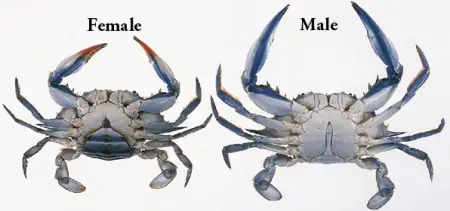Blue crabs are famous for their delectable tender meat.
But when we gorge on crabs, we don’t really check if we are about to eat a male or a female crab, do we? In some areas, it may be illegal to catch female crabs in order to allow it to reproduce, so it is very important to know how to distinguish a female crab from a male crab. In this article, the difference between male and female blue crabs will be discussed.
Summary Table
| Male Blue Crabs | Female Blue Crabs |
| Claws are bright blue | Claws are red-tipped |
| Apron is long and pointy (similar to the shape of the Washington Monument) | Apron looks like an inverted U (similar to the shape of the United States Capitol) |
| Broader body; more pronounced spines | Slightly narrow body than males; spines are not as accentuated |
| Molt twenty times until maturity | Molt eighteen times until maturity |
| Mate many times in a lifetime | Mate only once in a lifetime |
| Meat is flaky | Meat is dense; famous for the roe |
| Also called “jimmy” | Adult females are also called “sooks” while adolescent females are also called “sally” |
What is the Scientific Name of Blue Carbs?
Blue crabs have a unique scientific name, which is Callinectes sapidus. This name means “beautiful savory swimmer”! This seems to be an apt name for blue crabs since they are known to be great swimmers.
Where Do Blue Crabs Live?
Blue crabs live in the southern parts of the US, including along the coast of the Atlantic and the Caribbean, down to South America and Argentina.
Descriptions

A male blue crab, also called “jimmy” by boatmen, can be identified by its bright blue “chelipeds” or claws. Aside from its claws, a male blue crab can also be identified by the shape of its “apron,” which is the flap on its bottom. A male blue crab’s apron is long and has a pointed tip, which is often facetiously called the “Washington Monument” by watermen. It is also observed that a male has a distinct broad shape and very pronounced spines.
It is difficult to determine the sexual adulthood of the male blue crabs. However, you will notice that an adolescent male blue crab’s apron is shut, whereas an adult male blue crab’s apron is free to open, a sign of its readiness to mate. An adult male blue crab may mate many times in its lifetime. A male blue crab “molts” or sheds its exoskeleton about twenty times before reaching adulthood. Finally, males are believed to have flaky meat.
A female blue crab, or “sook,” has red-tipped claws. To easily remember this, people liken these red tips to the “red nails” of female human beings.
If flipped upside down, you will also notice that a female blue crab has a rounded or inverted U-shaped apron. As a mnemonic, people often say it has the shape of the United States Capitol. Adolescent female blue crabs, or “sally,” have triangle-shaped flaps and are also called “v-bottoms” in some areas.
A female blue crab sheds its shell about eighteen times until it becomes an adult. Upon reaching maturity, a female blue crab’s flap opens. The open flap is used to mate and to carry her eggs. It mates only once in its lifetime.
In areas where catching female crabs is allowed, females are eaten not only for their delicious meat but also for their roe (eggs). It is also believed that female crabs have dense meat.
Male vs Female Blue Crabs
What, then, is the difference between male and female blue crabs?
Male blue crabs have bright blue claws, whereas female blue crabs have red-tipped claws (often likened to the red painted nails of female humans). The apron of male blue crabs has the shape of the Washington Monument because it is long and pointy, while the apron of the female blue crabs has the shape of the United States Capitol because it is round. Males also have broader bodies and more pronounced spines than females.
What about size difference? One of the main ways to tell the difference between male and female blue crabs is by their size. Most male blue crabs are much larger than the females, especially during mating season.
However, because size can vary greatly within crab species, size is not always a reliable method to tell the sex of a crab.
In addition to their body size, you can also tell the difference between male and female blue crabs by the size of their claws. In most crab species, male crabs have larger claws, while the females’ claws are smaller.
In terms of molting, male blue crabs shed their shell about twenty times until maturity, while female blue crabs shed about eighteen times. Males mate several times in a lifetime, while females mate only once.
When it comes to the texture of their meat, males have flaky meat while females have dense meat. Females are also a favorite because of the roe (eggs).
Additionally, watermen call male blue crabs “jimmies,” adult female blue crabs “sooks,” and adolescent female blue crabs “sally.”
Other Interesting Facts About Blue Crabs
One of the largest blue crabs was caught in the Chesapeake. It measured a whopping 10.72 inches across and weighed 1.1 pounds!
Blue crabs are known to be cannibals. They live on the bottom of the ocean, where they eat fish, snails, mussels and plants. However, if they’re unable to find food, these crabs will gladly eat other blue crabs.
At that time, they can release more than 2 million eggs.
The blue crab is the Maryland state crustacean.





